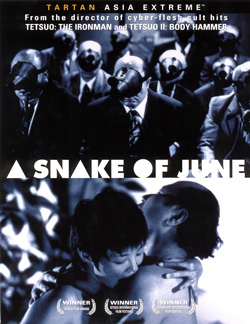Film
Index
Synopsis: Rinko is a thirty-something telephone counselor for a mental health line. She is trapped in a sexless marriage to Shigehiko, an obsessive compulsive man who is older than her. She is sexually repressed, he is a clean-freak. Their marriage has little contact between them. They seem to live in different worlds. One day, Rinko receives a package in the mail containing photographs of her taken by an unseen photographer. The photos are sexually revealing, taken as she indulged herself in a private fantasy. The blackmailer compells her to relive the fantasy, with himself pulling the strings. If she complies, he'll hand over the negatives. At her wits end, she agrees to his demands and in the process, awakens something within herself, and learns something about her blackmailer, as well. The photographer withholds one final negative, though, and gives it to her on the condition that she see her doctor. She does, and discovers that she has breast cancer. The blackmailer then turns his attention to Shigehiko, guiding him into a dark world of perverse sexuality...
Voyeur: The first shot of A Snake of June is of a camera. The first scene depicts a woman being photographed as she undresses. The movie instantly stakes out its place in the cinema of voyeurism. Like the best films in this region of cinema, this one makes the audience particularly uncomfortable. There is something about watching people in their most private, intimate moments that gets the audience squirming in their seats, and the images THIS film provides are unusually intimate. The second half of the film goes one better than the first half, too, in so far as it seems to inhabit poor Shigehiko. It offers a subjective viewpoint of his most unguarded moments, a viewpoint that more often than not takes a sharp turn into nightmare. The look of the film, already a stark, cold duotone of black and blue, amplifies this. Meanwhile, the audience is compelled to watch. The signature image in the film is a peepshow filled with patrons whose vision is constrained by conical viewers strapped to their faces. They watch the sex show, but they don't necessarily see the context. This film is very good at veiling its context behind a veneer of kink.
Under the Skin. Director Shinya Tsukamoto is best known in the West for his gonzo biomechanical freak-out, Tetsuo: The Iron Man. That film drew comparisons to David Cronenberg for its fusion of flesh and technology, but anyone who has kept up with Cronenberg's career will tell you that Cronenberg's main theme isn't biomechanical at all. Rather, it is philosophical. It is the disconnect between the mind and the body, between desire and its sexual realization. In this regard A Snake of June is far more Cronenbergian than Tetsuo. Like Cronenberg's best films, this one gets under the skin without the need for the props of science fiction and horror--though there's not a complete absence of such things in this movie.
Fetish: There is a sadomasochism in this movie that is more than up to the task of rubbing whatever exposed nerves the audience brings with them to the experience, It's not the sadomasochism of the leather freak or the dominatrix's dungeon. It dispenses with the props and theater of dominance and submission and presents the raw sexual needs behind them. This is not, as might be expected, a humilation with the aim of degradation. In both sets of relationships, the object is liberation. This comes first and most vividly to Asuka Kurosawa's Rinko, who repeats her sex game in the film twice: once under coersion, second at her own volition. The transformation in her overall demeanor is dramatic and convincing. Yuji Kohtari has a harder row to hoe, playing an obsessive compulsive whose inner life lends itself to the halucinatory nature of the second half of the film. Kohtari's character plums depths of humiliation for a much darker purpose than the arc Kurosawa plays. His release isn't anywhere in the agenda for the film's blackmailer, though his liberation results by accident.
The tone of the film, a conflation of pink films and film noir, suggests that the whole thing is headed for a bitterly tragic doom. Given the overall feeling of oceanic dread created by the anonymous city, the austere cinematography, and the constant rain, the release at the end of the movie is particularly unlooked-for. An unexpected boon, actually.

Tartan's new DVD of this movie bears some comment. The print of the film is full-frame, which will surprise some viewers expecting the customary letterbox. A savvy viewer might think that the print has been transferred unmatted, but this isn't the case. This is an unusual contemporary film intended for the academy ratio of 1.37:1. A word to the wise.
2/11/2005